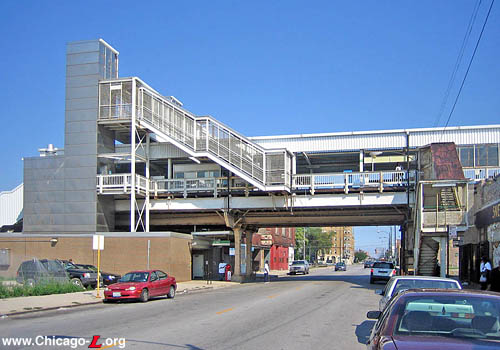
The 43rd station is seen
looking east on September 3, 2006. The simple, utilitarian
tan brick station house is visible under the elevated
structure on the left, with the stainless steel-clad
elevator towers added in the 1994-96 Green Line renovation
looming overhead. The auxiliary exit stairs from the
southbound platform are visible on the right. For a larger
view, click here.
(Photo by Graham Garfield)
|
43rd
(4300S/300E)
43rd Street and Prairie
Avenue, Grand Boulevard
Service
Notes:

|
Green Line:
South Side Elevated |

|
Accessible
Station |
Quick Facts:
Address: 314 E. 43rd
Street
Established: August 15, 1892
Original Line: South Side Rapid Transit
Previous Names: none
|
Skip-Stop Type:
|

|
Station
|
Rebuilt: 1976
(new station house),
1990 (new
platforms),
1996 (elevators added,
overall rehabilitation)
Status: In Use
History:
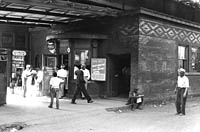
The original 43rd station
house is seen on August 8, 1957. Still largely in its
original condition, the station, with its polychromatic
brickwork and front bay, was typical of the South Side
Elevated stations designed by Myron Church. The doorway in
the front bay was a later modification. For a larger view,
click here.
(Photo from Graham Garfield Collection)
|
43rd Street station was built as part of the South Side Rapid
Transit's extension to the Columbian Exposition in 1892. The original
station building was a grade-level structure that resembled other
stations built as part of the extension, such as the building still
at Garfield and those now removed from
Indiana, 51st,
58th, and 61st.
Designed by architect Myron H. Church and built by the Rapid
Transit and Bridge Construction Company (under general contractor
Alfred Walcott and engineer R.I. Sloan), the station house was
designed with a Queen Anne-style influence. The building was
constructed of brick with stone sills and foundation with polychrome
brickwork along the top of the exterior in a latticed diamond
pattern. Perhaps the building's most prominent feature was the bay
that projected from the front elevation, with its broad half-cone
roof. The building's bay and brick frieze display many qualities of
the Queen Anne style, although the flat terra-cotta cornice and other
elements show some examples of early Chicago School of
architecture.
The dual side platforms, which were end-loaded at their north end,
consisted of a wooden deck on a steel structure. The original
canopies were humped-shaped, typical of the original South Side Rapid
Transit designs, but were replaced early on with short canopies of
steel posts supporting a flat tin roof.
In March 1959, auxiliary exit stairs were added to the 43rd
station, leading down from each side platform to the south side of
43rd Street, across from the station house. In addition, the stairs
to the northbound platform also served as an auxiliary entrance,
during Monday-Friday rush hours only, with an agent's booth located
at the top of the stairs. The auxiliary stairs were installed as part
of the larger effort to improve passenger facilities and circulation
at three South Side stations -- similar auxiliary stairs were
installed at 47th and Indiana's station house was refurbished -- and
to improve the appearance, alleviate congestion, and speed boarding
and alighting at 43rd station, which was very busy during peak times.
In addition to the new stairways, a 48-foot extension of the
southbound canopy, which would protect the full width of this
platform, was installed. These improvements at 43rd cost a total of
$22,000. The auxiliary stairs to the northbound platform continued to
function as a rush hour entrance until January 13, 1973, when it was
closed as a result of service cuts. Both remained as auxiliary exits,
however.
Station Reconstruction, Piece By
Piece
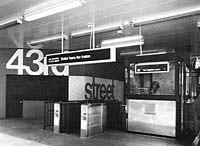
The new, open-air 43rd
station entrance is seen looking northwest in 1976 after
being reconstructed. The concession stand, under the "43rd"
super-graphic, is not yet occupied at this point. For a
larger view, click here.
(CTA Photo)
|
On April 1, 1974, the 43rd station house was destroyed by fire. The
station entrance was temporarily replaced by fare controls on the
auxiliary stairs across the street from the main entrance. The booth
on the northbound side, only recently deactivated the year before,
was put back in service and a temporary booth was installed at the
top of the auxiliary stairs on the southbound platform as well.
Work began quickly on rebuilding the main entrance. In June 1976,
the newly rebuilt station entrance opened at street-level and the
temporary platform booths were closed. The new station house was
simple, with tan brick exterior side and rear walls. The station had
no front facade, instead being fully open to the street. Certain
aspects of the station were very "modern" in the 1970s sense of the
word, with a large circular porthole on the east wall of the unpaid
area and "43rd street"
written in oversized "super-graphics" on the interior of the west
elevation. The station facility included a dual-position agent's
booth (initially staffed 24 hours a day), a couple coin/token
turnstiles, a concession stand, and a custodian's closet.
The new station house stood in contrast to the original 1892
platforms for several years. It was initially planned to replace the
platforms in 1986, but the project for further delayed for a few
years, in part because initial bids from contractors came in
over-budget.
Work began on the platform replacement project began in Spring
1990. In order to complete the work quickly and efficiently, it was
determined that the station would be closed and single-track
operations would be instituted through the project area. To lessen
the impact on passengers as much as possible, neighboring Indiana
station was temporarily changed from an "A" station to an "AB"
station, agent coverage at Indiana was
increased to 24 hours a day, and #43 43rd buses were rerouted to
serve the station.
43rd station closed at 7am on March 18, 1990 to allow work to
commence. The new station platforms included new wood decking, a new
full-width steel canopy over the north half, sodium vapor lights on
the south half, and new steel railings along the length of the
platform. The canopy had a slight peak to it, but only the portions
over the platforms and part of the tracks was actually covered. The
center of the canopy, between the tracks, was open. Sign brackets
were integrated into the railings. The auxiliary exit stairs from the
platforms to the south side of 43rd Street remained. The station
house was not altered as part of the platform project.
43rd station reopened at 10am on Monday, May 21, 1990, following
the completion of the platform and canopy renewal project, about a
month before the original projected reopening date. At that time, the
normal stopping pattern was resumed at 43rd and Indiana
stations and the #43 bus returned to its regular route.
Green Line Renovation
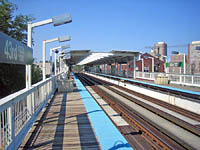
The 43rd station platforms
are seen looking north on September 3, 2006. The platforms
remain largely as they were rebuilt in 1990. For a larger
view, click here.
(Photo by Graham
Garfield)
|
On February 21, 1993, the South Side Englewood-Jackson Park service,
formerly paired with the Howard service and forming the North-South
Route, was repaired with the Lake Street service and formed the
CTA's new Green Line.
On January 9, 1994, the Green Line closed for a two-year
rehabilitation. All stations on the line, including 43rd, closed for
renovation.
Because the station was rebuilt within the previous 15 years, only
modest work was needed on the station during the rehabilitation. The
station house's basic structure remained, but was significantly
redressed and rearranged. The concession stand and existing interior
walls were removed. The porthole on the east elevation was sealed and
a series of rooms were constructed along the east side of the
interior, including a custodian's room and the new Customer
Assistant's booth, whose windows project out in a glass and steel
bay. The platforms and canopy were largely left as-is, having been
rebuilt just four years previous, but twin elevators were added to
make both platforms accessible. An overhead transfer bridge connects
the elevators above platform level, with stairs connecting down to
the platforms. The station also received new signage, windbreaks, and
heaters.
The Green Line and 43rd station reopened on May 12, 1996, but like
many other stations the work at 43rd was actually not quite complete
yet. The refurbished fare control area was not yet complete on
opening day, so entrance to the station was temporarily through the
auxiliary exit stairs on the south side of 43rd Street. Southbound,
there was a partial-service entrance with turnstiles that only
accepted coins, tokens, and monthly passes for full fare riders.
Final completion of the station's rehab, including activation of the
new elevators, did not come for a few months after the line reopened.
The berthing markers were not moved to their permanent locations
until February 27, 1997. The permanent station entrance and overhead
bridge at 43rd opened during Spring 1997.
The North-South Route (Temporarily) Returns, Thrice
In 2013, the CTA launched the Red Line South Reconstruction Project, a track renewal project to rebuild the Dan Ryan branch tracks from the bottom up, excavating down to the bottom of the trackbed to rebuild the underground drainage system then installing new ballast, ties, and tracks. Some modest station improvements were also performed. In order to perform the work more quickly and cost-effectively, the CTA closed the Dan Ryan branch for five months while work was performed. During that time, there would be no 'L' service on the Dan Ryan branch south of Roosevelt station.
As part of the alternate service plan for Dan Ryan riders, Red Line trains were rerouted via the old 13th Street Incline from the State Street Subway to the South Side Elevated, where they operated to Ashland/63rd via the South Side Elevated tracks in a pattern reminiscent of the old Howard-Englewood "A" trains of the North-South Route days. Harlem-Cottage Grove Green Line trains continued to operate as well, but due to limited track capacity some Green Line trains from Harlem that would've gone to Ashland/63rd were turned back to Harlem downtown during the weekday rush periods (at Roosevelt in the morning rush and via the Outer Loop in the evening rush).
Red Line service to Ashland/63rd began on Sunday, May 19, 2013. Following the five-month track reconstruction and renovation work on the Dan Ryan, Red Line service to 95th resumed at 4am, Sunday, October 20, 2013. At the same time, Red Line service via the South Side Elevated and Englewood branch was annulled and Green Line trains resumed service to Ashland/63rd, alternating between the two 63rd Street terminal branches.
Red Line service between Howard and Ashland/63rd via the South Side Elevated returned temporarily in 2017, although it was only select trains and only during weekday rush periods; during most times, normal service via the Dan Ryan branch continued. The diversion was necessitated by the $280 million 95th Terminal Improvement Project to expand and greatly improve the 95th/Dan Ryan Red Line station -- as construction continued on the new terminal, including foundations and structural steel work next to the tracks, track alignment work, and platform construction, CTA needed to close both the east and west platform tracks (at separate times), severely constraining capacity during rush and requiring a reduction in the number of trains in and out of the station.
On April 3, 2017, CTA began rerouting some Red Line trains, primarily in the off-peak direction, for a few hours each weekday onto the Green Line to or from the Ashland/63rd station. Reroutes onto the south Green Line in the off-peak direction took place in the morning (7:56 to 9:14am) and evening (4:40 to 5:58pm) rush periods (times at Roosevelt, just north of the diversion point); there were also a small number of trains that operated between Ashland/63rd and Howard in the peak direction, though primarily for car-balancing purposes. CTA officials said the reroute affected less than 10 percent of all Red Line trains.
The diversion of select rush period Red Line trains to/from Ashland/63rd lasted for approximately six months, with the last Howard-Ashland/63rd trains running Wednesday evening, November 22, 2017.
The Red Line Ashland/63rd service resumed on July 30, 2018, to allow additional work in, over and around the platform tracks at 95th/Dan Ryan; the last day of this iteration of the service last ran on April 26, 2019.
.
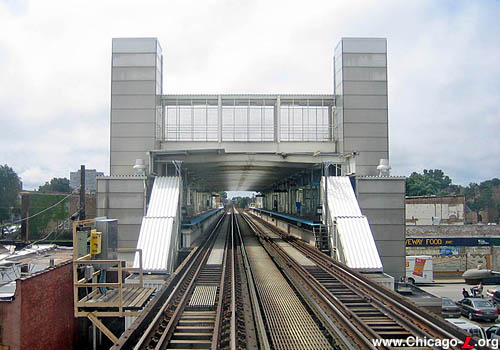
The 43rd station is seen
looking south on July 18, 2006. The platforms, canopy, and
stairs down to the station house seen in this view date from
1990. The elevator towers and overhead bridge were added in
the 1994-96 Green Line renovation. For a larger view, click
here.
(Photo by Graham Garfield)
|


|
43rd05.jpg
(72k)
This postcard from circa 1908 shows 43rd Street looking east
from Prairie Avenue. The "L" station is visible in the
background. (Postcard
from the Graham Garfield Collection)
|
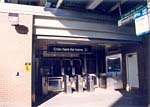
|
43rd01.jpg
(111k)
The simple brick station house and the fare controls and
Customer Assistant booth of the 43rd stop is seen looking
north in January 1998. (Photo by Linda
Garfield)
|
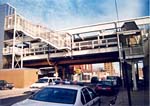
|
43rd02.jpg
(151k)
A view of the 43rd station complex. The entrance is in the
lower left corner. The elevator tower to the southbound
platform is visible in the upper left corner, with the
white-painted steel platform and stairs up to the overhead
bridge are visible across the center. (Photo
by Linda Garfield)
|
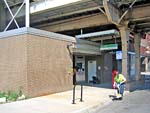
|
43rd09.jpg
(197k)
The simple 43rd station house is seen looking northeast on
September 3, 2006 as a
CTA® rail janitor
cleans in front of the station. The station entrance sign
was replaced about a year before with one of a newer style
which lists the station name and route name, rather than the
route name and destinations (seen here).
(Photo by Graham Garfield)
|
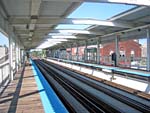
|
43rd10.jpg
(194k)
The 43rd station platforms are seen looking north on
September 3, 2006. Note that the center of the canopy is
open. The windbreaks are unusually shallow to accommodate
the narrow platforms.
(Photo by Graham Garfield)
|
|

|

|












